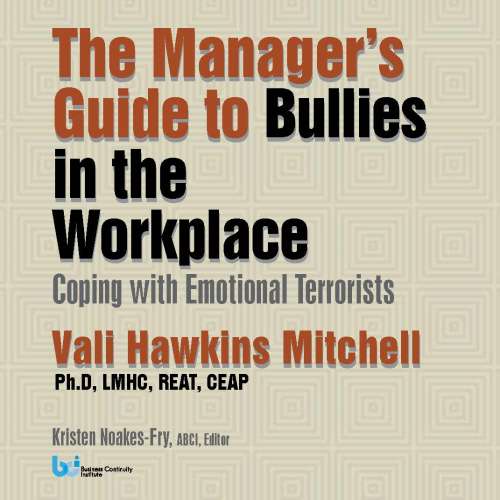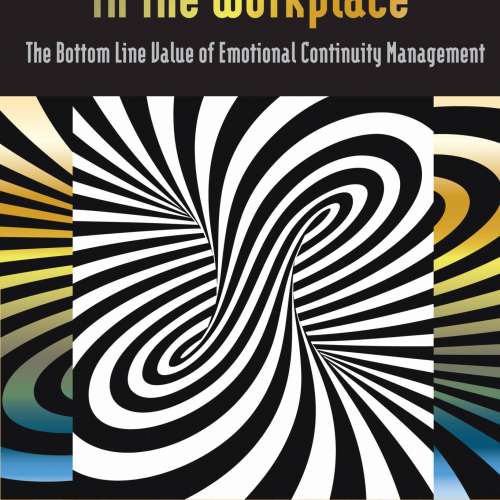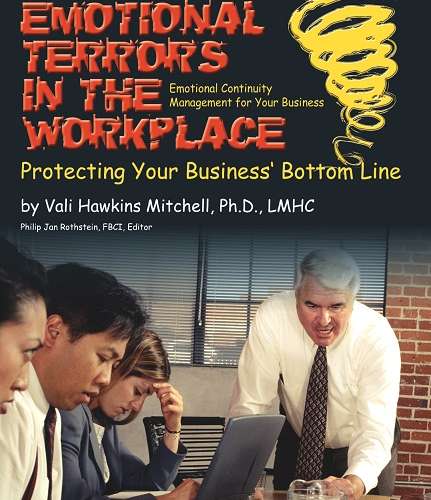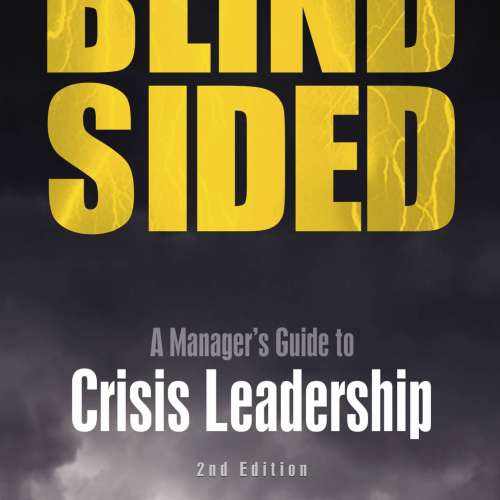Description
Workplace Violence Happens
For reasons that are beyond explaining, violence is present in our world. And sometimes it comes to the workplace. So, to help you remain safe without giving into fear, I want to introduce you to what I call fire extinguisher thinking. Workplace violence is more than a physical assault. Workplace violence is a much more complicated issue. Workplace violence can be one or more behaviors. It is ANY act or behavior where another person is abused, threatened, intimidated or assaulted in his or her place of employment.
Gossip chains, rumors, cursing, verbal abuse, threats, implied threats, teasing, pranks, arguments, property damage, vandalism, sabotage, pushing, theft, physical assaults, psychological trauma, racism, genderism, ethnic jokes, anger-related incidents, sexual innuendo or assault, arson and suicide, and murder are some of the examples of workplace violence.
Education about what workplace violence is and how to manage it, is the key to decreasing risks.
Dan Blasdel, Franklin County, Washington State, Coroner and former president of the International Association of Coroners and Medical Examiners said, “The key to lowering deaths in the workplace is through education, not only for employees, but also for employers. Employers have to make the workplace safer, and employees have to become more aware of their surrounding and also be more proactive in watching out for co workers.”
Workplace Violence in its raw form is simply a destructive force of energy.
By that definition a tornado is violent as is a gentle wave that washes over and destroys a child’s sand castle. Violence is at its core essentially a form of energy communication that is neutral until it comes in contact with something. Violence is distorted communication that has so much “force and energy” behind it that it can annihilate, demolish, devastate, raze, break, trash, wreck and ruin something else in its way. When a human being is violent, they are indeed communicating something but in a distorted, bizarre or grotesque manner that causes harm. By the time someone has lost the capacity to communicate within reason and escalates or resorts to violence, normal management skills like negotiation and tradition communication strategies are of little value A tornado doesn’t negotiate!
Also check out:
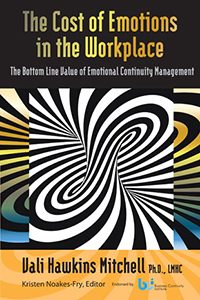
Excerpt from the Introduction
Violence Happens
For reasons that are beyond explaining, violence is present in our world. And sometimes it comes to the workplace. So, to help you remain safe without giving into fear, I want to introduce you to what I call fire extinguisher thinking.
Fire Happens
Most companies have fire extinguishers, but managers don’t carry them around all day ready to use. People are trained in how to use the fire prevention equipment, know where they are stored near or in the office, and are therefore prepared and willing to use a fire extinguisher if needed. Most people go about their day without wallowing in paranoia that there may be a fire at any moment.
I believe the same behavior should be used when considering the threat or risks of workplace violence. Just as managers need to manage everyone getting on board on the use and misuses of using the fire extinguisher without over-reacting or under-reacting to the risks, most people also know that a “fire” of violence can potentially erupt at any moment at any place just like a real fire. Because this unfortunate reality demands a certain level of attention, everyone needs to be prepared and managers especially need to be ahead of the curve in order to lead.
Managers really have the hardest work! They must negotiate between what upper-level owners, administrators, CEOs and other stakeholders want, and require to protect and serve the bottom line, while they are also accountable for the line-staff’s day-to-day well-being. These stresses can take a toll with just the regular workload. Now, on top of that, you must add legitimate concerns about managing the risks of workplace violence. You need the knowledge to be the model of awareness, but you also have the opportunity to influence a workplace culture of violence into a culture of peace and productivity. Being aware and educated about workplace violence is not about being negative, pessimistic or being afraid. It is about being smart. Being a model for your staff also adds a significant element of strength and competency to your own self-care and well being practices. They want the same from you. Resiliency means you get up again even in the ace of duress, which can mean day-to-day stuff, or the unexpected violent event. As you build your own resiliency practice, you can teach and model what it looks like to your employees. This is another form of leadership excellence that takes you from being a manager to a being a leader.
Awareness Happens
- First: Get your workplace violence fire extinguisher thinking in place.
- Second: Learn everything you can about the topic and how to manage the risks.
- Third: Gather your resources, create policies, review everything regularly; be current.
- Fourth: Train everyone on everything you know because you don’t know who will be left standing in case of an incident.
- Fifth: You are more ready today than yesterday, so reject any lingering fear and paranoia.
- Sixth: Develop a personal extreme self-care protocol and protect it fiercely. Teach it. Model it. Use the resiliency tips and images included in this book to model creating a culture that rises above fear. Stand strong, take a breath, and feel great that you are getting people safer by preparing for the worst, unthinkable, unimaginable, and unbearable, while expecting and planning and working and striving for the most peacefully productive worksites ever.
Although most workplace violence events do not escalate to the level of mass murder, sadly some do. Just as an unattended flame may go out or may become a conflagration, managers need to plan for all levels to keep everyone safe. Consider just a few of these 2016 headlines – while remembering to move toward awareness and not to slip into fear:
- On May 4, 2016, a man who had been involuntarily terminated two weeks earlier returned to his former workplace armed with a shotgun and a pistol. He was reported to have said words to the effect of “You all ruined my life” then shot and killed a 34-year-oldsupervisor, injured two other employees and then killed himself (ABC Eyewitness News, 2016).
- On February 26, 2016, a 38-year-old shot and killed three people and injured 14 other people. A co-worker reported that approximately two hours after the two men had clocked in for their shift at work that day, he saw the shooter strapped up with his weapon and shooting at people in the factory’s parking lot (Bonczyk, 2016).
- On March 20, 2016, a 55-year-old retired state trooper shot and killed a toll booth worker before he was shot and killed by the authorities (Howard, 2016).
- On April 8, 2016, at Lackland Airforce Base in San Antonio, TX, a man was being escorted to a disciplinary hearing, when he committed a murder-suicide (Forsyth, 2016).
- On December 2, 2015, a county health inspector and his wife burst into a banquet room in San Bernardino, CA, where approximately 80 co-workers were gathered to attend a holiday party, shot 14 people dead and injured 22 others. The couple also attempted to bomb the facility (Almasy, 2015).
- On August 26, 2015, a disgruntled ex-reporter killed two former colleagues live on television (Bonczyk, 2016).
What can you do to model changing the culture to a more mindful workplace today?
Make a start. Peace will not be popular in a workplace until it makes a profit. Make your company profitable not only for its business focus, but for being a peaceful workplace. You can help move the energy toward a new trend in business. Do not accept that the “way we’ve always done it” is enough in a world that is changing rapidly. Demand something beyond a flat “zero-tolerance” policy. Demand a proactive peace and resiliency, mindful and aware attitude. Create a new trend. Be that person.
Vali Hawkins Mitchell
Honolulu, Hawaii
January, 2017
Contents
Dedication
Acknowledgments
Introduction
Part 1: Understanding Workplace Violence
1.1 A Complicated Issue
1.1.1 Violence Defined
1.1.2 Type of Violence in the Workplace
1.1.3 Categories of Workplace Violence
1.1.4 The Components of Violence
1.2 Warning Signs of Violence in the Workplace
1.2.1 Observing the First Signs
1.2.2 Observing Non-Verbal Signs or Body Language
1.2.3 Observing Other Signs of Potential Violence
1.2.4 Observation to Response: Respond, Don’t React
1.3 How Domestic Violence Becomes a Problem in the Workplace
1.3.1 Stalking
1.3.2 Observable Behaviors May Suggest Domestic Violence
1.3.3 Managing Domestic Violence Issues in The Workplace
1.3.4 What can you do as a manager?
1.3.5 The Cost of Domestic Violence to Businesses
1.4 Coping with Violence in the Workplace: Managers in the Crosshairs
1.4.1 The Responsibility of Management
1.4.2 Managers and Codependency
1.5 Best Practices for Managers
1.5.1 Reality vs Denial
1.5.2 Resistance and Avoidance
1.5.3 Your Life
1.5.4 Target
1.5.5 CEOs set the tone
1.5.6 Become Very Clear
1.6 Managing: What do you need to Master
1.6.1 Human Factors
1.6.2 Management vs Power vs Control vs Violence
1.6.3 Learn All the Rules, Laws, Guidelines, Policies, Procedures
1.6.4 Develop and Fiercely Protect a Self-Care Practice
1.6.5 Become Proactive about Violence Prevention
1.6.6 Learn Different and Important Communication Skills
1.6.7 Create a New Culture of Non-Violence
1.6.7.1 Train Everyone: Participatory Democracy
1.7 Managing: Administrative Factors
1.7.1 Threat Assessment Documentation
1.7.2 Create a Basic Written Policy Statement
References
Part 2: Incident Management Planning: Assessing a Workplace Violence Incident Management Plan
2.1 What Is Workplace Violence?
2.2 The Threat
2.3 Who Is Vulnerable?
2.4 What Is the Cost?
2.5 Proactive Incident Management Planning
2.5.1 The Organization’s Responsibility
2.5.2 Documented Steps
2.5.3 Incident Management
2.6 Crafting a Response to Workplace Violence
2.7 Assessing a Workplace Violence Incident Management Plan
2.8 Summary
References
Part 3: The Active Shooter
3.1 What Is an Active Shooter?
3.2 Motivation and Goals of the Shooter
3.2.1 Areas of Greatest Risk
3.2.2 Targets
3.2.3 Weapons of Mass Destruction
3.2.4 Active Shooter Scenarios
3.3 Why do You Need to be Educated?
3.3.1 Mass Shootings in the Past Few Years
3.4 Instinctive Responses in the First Moments
3.4.1 Denial
3.4.2 Panic
3.5 What to Do and Not Do
3.5.1 Choices Before an Active Shooter (Or Emergency Event)
3.5.2 Choices During an Active Shooter Event
3.5.2.1 Run
3.5.2.2 Hide
3.5.2.3 Fight
3.5.2.4 Survive
3.5.3 What to Expect or Consider About Law Enforcement
3.5.3.1 Their Role
3.5.3.2 What You Can Expect
3.5.3.3 How You Should React
3.6 Advance Preparation and Training
3.6.1 Create a Plan
3.6.2 Training for Active Shooter Situations
3.6.3 Indicators of Risk for Potential Violence
3.6.4 What it Takes to Survive
3.7 Resources for Staff Training
References
About the Author
More books from this Author
About the Author
Vali J. Hawkins Mitchell, Ph.D., LMHC, REAT, holds a Doctorate in Health Education and Masters degrees in Applied Psychology  and Expressive Arts Therapy and is a highly regarded public speaker, trainer, author, consultant, and educator. A valued mentor and keynote speaker, she offers critical insights on the real human factors of disaster and emergency planning based on her experiences with major events such as the World Trade Center, Hurricane Katrina, Samoan earthquakes, Indonesian tsunami, and Pacific Northwest Wildfires. She is considered by many as the leading authority in the growing field of Emotional Continuity Management.
and Expressive Arts Therapy and is a highly regarded public speaker, trainer, author, consultant, and educator. A valued mentor and keynote speaker, she offers critical insights on the real human factors of disaster and emergency planning based on her experiences with major events such as the World Trade Center, Hurricane Katrina, Samoan earthquakes, Indonesian tsunami, and Pacific Northwest Wildfires. She is considered by many as the leading authority in the growing field of Emotional Continuity Management.
Academically, Dr. Hawkins Mitchell has been adjunct faculty member and guest lecturer at a number of universities and colleges, including Washington State University, the World Medicine Institute, and Lane Community College. Dr. Vali, as she is well known, has contributed original research in the area of Psychosocial Dynamics of Families with Pediatric Illness, Tools of Trauma Management for Emergency Care and Health Care Delivery Professionals, and the Use of Quantum Poetry for Trauma Management. She has been trained by the American Red Cross as a Disaster Mental Health provider and National Diversity Instructor, and has been consulting directly with military families and service members in all branches since 2009.
Dr. Vali travels extensively providing custom-designed trainings for individuals and teams, private and government agencies, mom-and-pop companies, and large corporations. Dr. Vali is the author of The Cost of Emotions in the Workplace: The Bottom Line Value of Emotional Continuity Management (Brookfield, CT: Rothstein Publishing, 2013). She has also written Dr. Vali’s Survival Guide: Tips for the Journey; Preparing a GoBag; and a number of plays, musicals, and children’s titles. She is a performance musician and award-winning artist. She is a Registered Expressive Arts Therapist (REAT). She recently relocated her art studio and professional office from Seattle, Washington to Honolulu, Hawaii.
Excerpt: How Domestic Violence Becomes a Problem in the Workplace
1.3 How Domestic Violence Becomes a Problem in the Workplace
As mentioned above in Section 1.2.3, domestic violence is yet another under considered and often avoided topic in the discussion of workplace violence. Unfortunately, home duress can and does spill into the workplace. According to The Facts on the Workplace and Domestic Violence (2016), “Domestic violence is a pattern of coercive behavior, including acts or threatened acts, that is used by a perpetrator to gain power and control over a current or former spouse, family member, intimate partner, or person with whom the perpetrator shares a child in common. It occurs in heterosexual and same-sex relationships and impacts individuals from all economic, educational, cultural, age, gender, racial, and religious demographics. Domestic violence includes, but is not limited to physical or sexual violence, emotional and/or psychological intimidation, verbal abuse, stalking, economic control, harassment, physical intimidation, or injury.”
According to the American Bar Association, Standards of Practice Commission on Domestic and Sexual Violence (2016), delegates in August 2007 adopted the “black letter” law of the Standards of Practice for Lawyers Representing Victims of Domestic Violence, Sexual Assault and Stalking in Civil Protection Order Cases. These standards are intended to improve the quality of legal representation provided to victims of domestic violence, sexual assault, and stalking. Legal standards regarding domestic violence are good news for managers, since there will be increased awareness and more resources for you and for victims. The bad news is that you may be more likely to be required to testify and provide documentation in court on behalf of victims. It could also mean you could become the target of perpetrators who are angry and resentful. Your primary defense is to become aware and educated about state and industry requirements. You also need to know if your company will back you and pay for any legal fees you may incur. You may need to protect yourself as well as your company.
1.3.1 Stalking
Stalking can be initially difficult to discern because the behavior starts with what appear to be normal “attentive” behaviors. It is considered a criminal activity if the behavior becomes repeated through following and/or harassing another person over time. It can first look like sending gifts, email or love notes, or even waiting for someone after work, all of which may appear harmless. But when there is an intent to instill fear, control, or injury, it becomes something dark, dangerous, and criminal. Though anti-stalking laws are gender-neutral, most stalkers are men and most victims are women. To review Criminal Stalking Laws by state current through July 20, 2015: go to: //victimsofcrime.org/our-programs/stalking-resource-center/stalking-laws/criminal-stalking-laws-by-state.
According to a Bureau of Justice (BOJ) Special Report, during a 12-month period, an estimated 3.4 million persons, age 18 or older were victims of stalking (Baum, 2009). The BOJ, in a Supplemental Victimization Survey (SVS), conducted in 2006, identified seven types of harassing or unwanted behaviors consistent with conduct experienced by stalking victims (Baum, 2009):
- Making unwanted phone calls.
- Sending unsolicited or unwanted letters or e-mails.
- Following or spying on the victim.
- Showing up at places without a legitimate reason.
- Waiting at places for the victim.
- Leaving unwanted items, presents, or flowers.
- Posting information or spreading rumors about the victim on the internet, in a public place, or by word of mouth.
The survey reported that “over a 12-month period an estimated 14 in every 1,000 people age 18 or older were victims of stalking, almost half experiencing at least one unwanted contact per week, divorced or separated individuals were at higher risk, as were women more than males”(Baum, 2009). The increase in cyberstalking opportunities, instant messaging, social media and text messaging makes today’s stalking even more relevant for risk of workplace violence.
Stalkers are able to communicate electronically and often anonymously, creating a heavy-to–bear sense of “what might be next” that the victim may experience during work hours (Baum, 2009). Victims may be hesitant to report stalking, dismissive of it, or unsure of their own perception of what comprises stalking. Managers need to include information about stalking safety in their workplace violence trainings.
The following suggestions cannot guarantee safety, but they are a place to start:
- Seek Advice from a trained professional, lawyer, or resource such as the National Center for Victims of Crime Stalking Resource Center: //victimsofcrime.org/our-programs/stalking-resource-center/stalking-information
- Don’t try to deal with a stalker alone.
- Vary your daily routine, times, and travel patterns.
- Get rides with trusted colleagues or friends for work or recreation.
- Protect your personal information.
- If you know the stalker, identify safe places to stay.
- Your lawyer may advise you that you can tell the stalker once through registered mail, email, or through your attorney to stop harassing you under any circumstances. Then you have proof you were appropriate and can file for extended legal protections as needed.
- Document everything such as time or place and all details of any and all communications by the stalker.
…

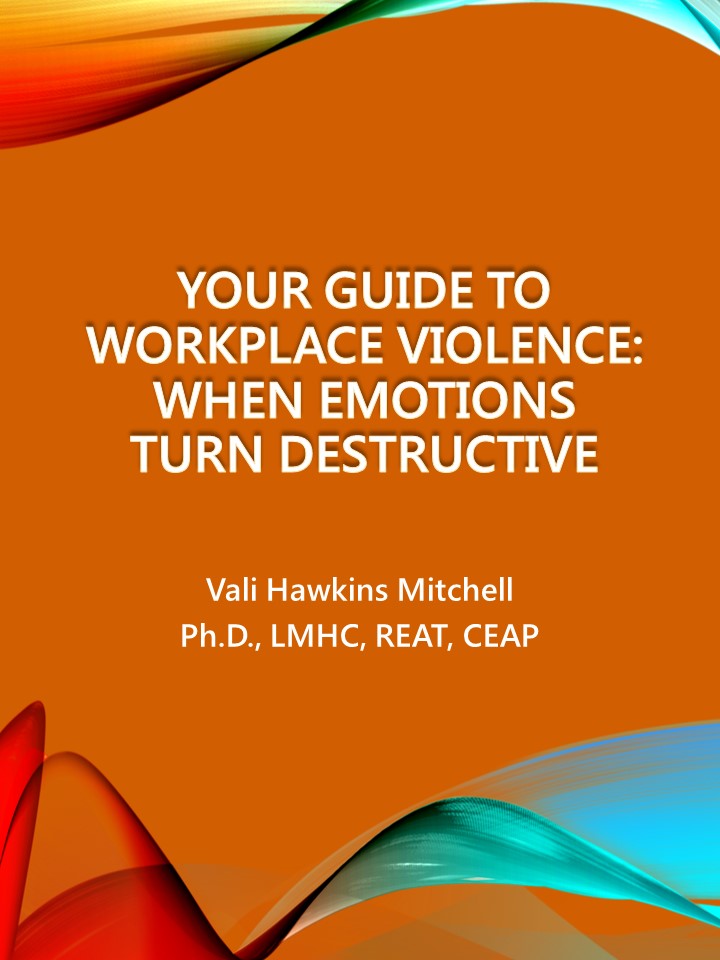


 and Expressive Arts Therapy and is a highly regarded public speaker, trainer, author, consultant, and educator. A valued mentor and keynote speaker, she offers critical insights on the real human factors of disaster and emergency planning based on her experiences with major events such as the World Trade Center, Hurricane Katrina, Samoan earthquakes, Indonesian tsunami, and Pacific Northwest Wildfires. She is considered by many as the leading authority in the growing field of Emotional Continuity Management.
and Expressive Arts Therapy and is a highly regarded public speaker, trainer, author, consultant, and educator. A valued mentor and keynote speaker, she offers critical insights on the real human factors of disaster and emergency planning based on her experiences with major events such as the World Trade Center, Hurricane Katrina, Samoan earthquakes, Indonesian tsunami, and Pacific Northwest Wildfires. She is considered by many as the leading authority in the growing field of Emotional Continuity Management.